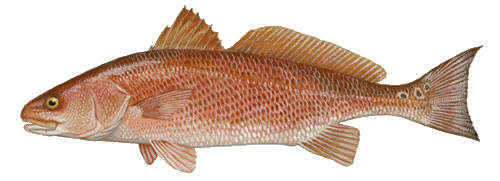
Red Drum
Red drum derive their name from the croaking or drumming sound they produce by resonating their large swim bladder. Historic distribution of the species on the Atlantic coast is from the Gulf of Main to northern Mexico. They are most abundant in the Gulf of Mexico and along the Atlantic coast , and can be found near the Chesapeake Bay mouth in salinities above 15 parts per thousand.
Red Drum
 Red drum are generally iridescent silvery-gray in overall color, with a coppery cast that is usually darker on the back and upper sides. They also have one (or more) black ocellar spots on the upper sides near the base of the tail and elongated and robust body. Their Maximum adult size is nearly 5 feet (1.5 meters) total length and the largest caught in Maryland in 1977 in the Tangier sound weighed just over 74 pounds.
Red drum are generally iridescent silvery-gray in overall color, with a coppery cast that is usually darker on the back and upper sides. They also have one (or more) black ocellar spots on the upper sides near the base of the tail and elongated and robust body. Their Maximum adult size is nearly 5 feet (1.5 meters) total length and the largest caught in Maryland in 1977 in the Tangier sound weighed just over 74 pounds.
Season:
The recreational season for catching red drum is open year-round. Adult red drum occur in Chesapeake Bay from May through November. Surf casters along the 35 miles of Maryland's Atlantic coast catch large red drum in late fall and may occasionally catch smaller legal-size fish.
Currently, recreationally caught red drum must be at least 18 inches but no more than 27 inches to keep, and anglers are permitted 1 fish/person/day. Commercially caught red drum must be 18 to 25 inches, with a five fish per day limit. For current recreational and commercial size and creel limits, see Maryland's updated regulation page.
Opportunity:
Adult red drum occur in Chesapeake Bay from May through November and are most abundant near the bay mouth in salinities above 15 parts per thousand. Juveniles are most abundant in estuarine waters and inlets, while fish older than age-5 primarily inhabit coastal and offshore waters, often in large schools. Many anglers also like to fish for red drum at night, along shoals near the mouth of the Bay.
Anglers use either lure or bait to fish for redfish. Lures are the most common offering when fishing in the shallows, and include plugs, bucktails, spoons and soft plastic jigs. Baits including soft or peeler crab, Menhaden, spot, clams, mullet and shrimp are commonly used at night and when surf fishing for red drum.
License and Regulations
Simple, quick, and at the palm of your hand, DNR’s app is the easiest way to get your Maryland fishing license. Download the app on your smartphone (MD DNR), click Apply for License, and enroll. From the app, you can also register any catches, post photos, and check for regulations updates. Or, you can apply for a license through Maryland Department of Natural Resources’ website. There are a few instances where registering for a license may not be necessary; visit Maryland DNR for a full list of these exceptions. For more information on fishing without a license – and locations where licenses are not required – visit http://dnr.maryland.gov/Fisheries/Pages/Free-Fishing.aspx. Visit the Maryland Department of Natural Resources for a complete list of Maryland’s Fishing Regulations.
Money generated from the sale of licenses goes directly to the conservation, protection, and preservation of Maryland’s natural habitat and cherished wildlife. Maryland DNR works tirelessly to maintain a healthy population of fish and game, and the regulations needed to sustain fishing and hunting in Maryland. Changes in regulations, dates, and requirements vary year-to-year. Please check with DNR frequently for the most up-to-date information.